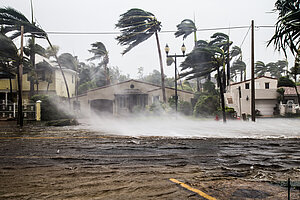May 4, 2021
The newly established International Telecommunications Union (ITU)/World Meteorological Organization (WMO)/United Nations Environment Programme (UNEP) Focus Group on “AI for Natural Disaster Management” (FG-AI4NDM ), officially kicked off with an online workshop and meeting from March 15 to 17. The event drew more than 180 participants from around the globe and highlighted the breadth of activities in natural disaster management incorporating AI methods. The group is chaired by Dr. Monique Kuglitsch, Innovation Manager at Fraunhofer Heinrich Hertz Institute (HHI).
FG-AI4NDM is building a community of experts and stakeholders to explore current practices (and untapped potential) in the use of AI to support: data (collection, real-time monitoring, and handling), modeling (reconstructing, detecting, forecasting, and projecting), and communication (early warning systems, etc.) in the context of natural hazards and disasters. The planned outcomes of this focus group will be a roadmap of how AI is currently being used in this domain (as well as an analysis of best practices, gaps, and future directions), non-normative technical reports, and educational materials to support capacity building. To encourage participation in these activities, FG-AI4NDM will be hosting workshops and meetings every several months.
The opening session of the workshop featured keynote presentations from Dr. Chaesub Lee (Director of the ITU Telecommunications Bureau), Dr. Monique Kuglitsch, Prof. Jürg Luterbacher (Director of Science and Innovation and Chief Scientist of the WMO and Vice Chair of FG-AI4NDM), and Dr. Muralee Thummarukudy (Operations Manager for the Crisis Management Branch at the UNEP), which highlighted the importance of interdisciplinary and multi-stakeholder collaboration to enhance natural disaster preparedness and response.
These were followed by three sessions of presentations and discussions.
Session two explored: how can AI be used to interpret and monitor data in the context of floods, avalanches, tsunamis and earthquakes? To address this question, high-caliber presentations were provided by Prof. Raúl Aquino (University of Colima, Mexico), Dr. Alec Van Herwijnen (WSL Institute for Snow and Avalanche Research SLF, Switzerland), Dr. Brendan Crowell (Pacific Northwest Seismic Network, U.S.), and Jannes Münchmeyer (GFZ German Research Centre for Geosciences, Germany), respectively. Benefitting from considerable engagement from the audience, Dr. Kuglitsch moderated the ensuing discussion.
Session three addressed: how can AI be used to reconstruct, forecast, and project atmospheric hazards and floods? This session was moderated by Prof. Alberto Montanari, President of the European Geosciences Union and faculty member at the University of Bologna, Italy, and included thought-provoking presentations from Prof. Kei Yoshimura (University of Tokyo, Japan), Dr. Elena Xoplaki (Justus Liebig University of Giessen, Germany), Dr. Carlos Gaitan (Benchmark Labs and American Meteorological Society Committee of AI Applications to Environmental Science, U.S.), and Dr. Serena Ceola (University of Bologna, Italy).
Session four considered: how can AI support effective communication in the case of an emergency and what role can capacity building play? Presentations from Steven Stichter (Director of the Resilient America Program at the National Academies of Science, Engineering, and Medicine, U.S.), Dr. Rakiya Babamaaji (Vice Chair of Africa Science and Technology Group on Disaster Risk Reduction, Nigeria), and Hans (Hyungsoo) Kim (Korea Telecom and ITU Study Group 2), showed the importance of engaging community stakeholders, facilitating capacity building, and leveraging telecommunications systems to enhance resilience. Yanchuan Wang (Vice Chair of FG-AI4NDM and Vice Chair of ITU Study Group 2 of China Telecom) moderated the session and provided a series of questions that nurtured a lively discussion.
To close the workshop, Dr. Bilel Jamoussi (Chief of the Study Groups at ITU) and Dr. Kuglitsch provided final remarks.
During the subsequent meeting, FG-AI4NDM participants considered proposals for the focus group structure, the composition of deliverables, and use cases. The approved use cases led to the establishment of three topic groups looking at “AI for flood data monitoring” (Chaired by Dr. Raúl Aquino, University of Colima, Mexico), “AI for landslide data monitoring” (Chaired by Dr. Silvia Garcia, National Autonomous University of Mexico, Mexico), and “AI for Tsunami data monitoring” (Co-chaired by Allison Craddock and Dr. Attila Komjathy, both of NASA Jet Propulsion Laboratory, U.S.). In addition, Dr. Muralee Thummarukudy and Dr. Elena Xoplaki were appointed Focus Group Vice Chairs.
The next FG-AI4NDM workshop and meeting will be held 23-25 June. For more information about FG-AI4NDM (including ways of becoming involved), please visit the website .
